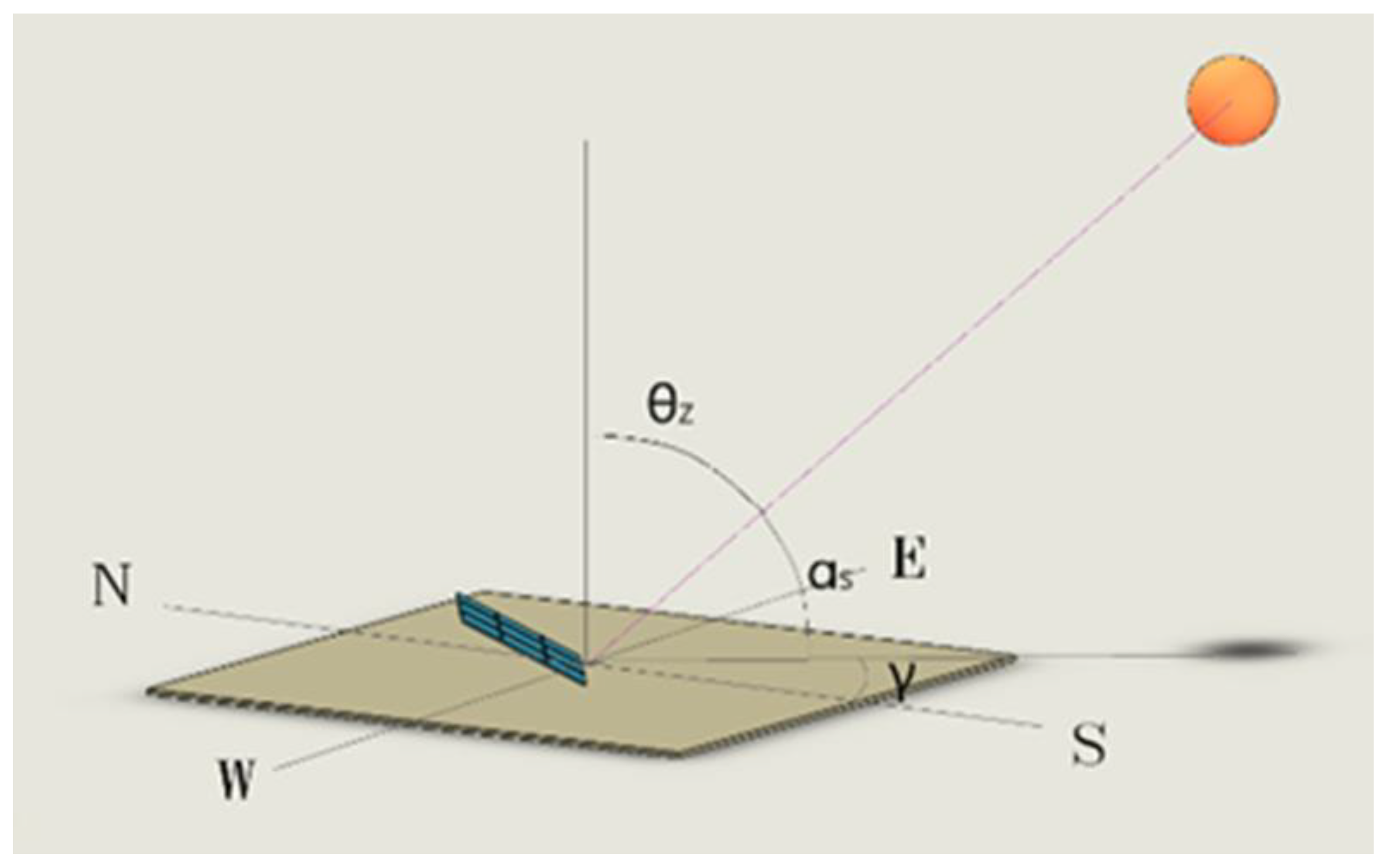A Review of the Sustainable Development of Solar Photovoltaic Tracking System Technology
Abstract
1. Introduction
2. Photovoltaic Cell
| Technology | Efficiency | Manufacturing Process | Advantages | Limitations |
|---|---|---|---|---|
| Monocrystalline Silicon | 15–25% | The m-Si wafers are manufactured using the Czochralski process, which involves growing silicon ingots from small single-crystal silicon seeds and subsequently cutting them to obtain m-Si wafers. | Stable; efficient; long lifespan. | High production costs; sensitivity to temperature; absorption issues; significant material loss. |
| Polycrystalline Silicon | 10–18% | Polycrystalline silicon can be industrially produced using the Siemens process. This method encompasses the vaporization of metallurgical-grade silicon, distillation of the resulting product, and final deposition to achieve ultra-pure silicon. | Simple production process; cost-effective; reduces silicon wastage; superior absorption compared to amorphous silicon. | Lower efficiency; more temperature-sensitive. |
| Gallium Arsenide | 28–30% | GaAs is made through a reaction of Ga and As in vapor, with a four-step process: growing a crystal ingot, processing a wafer, adding thin slices through epitaxy, and making devices by bonding, adding layers, isolating, and packaging. | High stability; low-temperature sensitivity; excellent absorption; high efficiency. | Extremely expensive. |
| Amorphous Silicon | 5–12% | The production of a-Si thin-film solar cells uses a roll-to-roll technique. Metal sheets are cleaned, cut, and coated with insulation. a-Si is deposited onto a reflector, followed by a transparent conductive oxide on the silicon layer. Laser cutting connects layers, and the module is encapsulated. | Inexpensive; abundant; non-toxic; high absorption coefficient. | Low efficiency; difficult material doping; short minority carrier lifetimes. |
| Cadmium Telluride | 15–16% | CdTe solar cell manufacturing involves depositing cadmium sulfide and CdTe layers. Laser cutting introduces an insulator, enabling the addition of the positive electrode. The cell is then encapsulated, wired, and placed on tempered glass. | High absorption coefficient; requires fewer materials for manufacturing. | Lower efficiency; cadmium is highly toxic; tellurium is limited and more temperature-sensitive. |
| Copper Indium Gallium Selenide | 20% | CIGS solar cell manufacturing involves choosing a substrate, applying a molybdenum film as the back electrode, growing the p-type CIGS layer, depositing a transparent conductive oxide buffer layer, and adding an anti-reflective coating to improve cell efficiency. | Requires fewer materials for manufacturing. | Very expensive; unstable; highly temperature-sensitive; unreliable. |
| Dye-Sensitized Solar Cells | 5–20% | The manufacturing process of DSSCs involves the deposition of a conductive layer, typically tin oxide, onto a glass substrate. Subsequently, an organic dye, capable of photon absorption, is applied on top of the conductive layer. Following this, an electrolyte, commonly in liquid form, is injected to provide a pathway for electron conduction. Finally, the cell is sealed through encapsulation to protect it from environmental influences. | Low cost; low-light performance; wide-angle sensitivity; low internal temperature; robust and durable; long lifespan. | Issues with temperature stability; presence of toxic and volatile compounds. |
| Quantum Dot Solar Cells | 11–17% | The manufacturing process of quantum dot solar cells involves selecting a conductive solid substrate, synthesizing semiconductor materials in the form of quantum dots with specific optoelectronic properties, attaching the synthesized quantum dots to the substrate to form a sensitized layer, introducing a liquid electrolyte for electron conduction, using conductive materials like platinum as electrodes, and finally encapsulating the cell for stability and protection from external influences. | Low production cost; low power consumption. | Highly toxic properties; degradable. |
| Perovskite Solar Cells | 21% | The manufacturing process of perovskite solar cells involves preparing a substrate (typically glass or flexible material), depositing electron and hole transport layers for efficient electron conduction, applying a perovskite layer, adding metal electrodes to collect electrons and holes, and finally encapsulating the components for enhanced stability and durability against environmental factors. | Inexpensive and simple structure; lightweight; flexible; high efficiency; low production cost. | Unstable |
| Multi-junction solar cells | 36% | The manufacturing of multi-junction solar cells involves substrate preparation, deposition of semiconductor layers, incorporation of a transparent conductive layer, possible stacking for broader absorption spectrum, introduction of metal electrodes for charge collection, and final encapsulation for stability and environmental protection. This complex process aims to maximize the use of diverse sunlight wavelengths for efficient energy conversion. | Highly efficient | Complex; expensive. |
3. Solar Radiation Angle Calculation and Theory
4. Solar Tracking System Technological Advancements and Classifications
4.1. Classification Based on Drive Mechanisms
4.1.1. Passive Tracking Systems
4.1.2. Active Tracking System
4.2. Classification Based on Degrees of Freedom
4.2.1. Single-Axis Solar Tracking System
4.2.2. Dual-Axis Solar Tracking System
5. Limiting Factors Affecting the Performance and Efficiency of Solar Tracking Systems
5.1. Cost
5.2. Geographical Environment and Climatic Conditions
6. Conclusions and Prospects
Author Contributions
Funding
Data Availability Statement
Conflicts of Interest
Nomenclature
| STS(s) | solar tracking system(s) |
| ST | solar tracking |
| PV | photovoltaic |
| m-Si | monocrystalline silicon |
| p-Si | polycrystalline silicon |
| a-Si | amorphous silicon |
| ANFIS | Adaptive Neuro-Fuzzy Inference System |
| DC | direct current |
| CIGS | copper indium gallium selenide |
| DSSCs | dye-sensitized solar cells |
| GaAs | Gallium arsenide |
| CdTe | cadmium telluride |
| SMA | smart shape memory alloy |
| LDR | light-dependent resistor |
| UV | ultraviolet |
| GPS | Global Positioning System |
| MPPT | Maximum Power Point Tracking |
References
- Zhang, G.; Zeng, G.; Li, C.; Yang, X. Impact of PDO and AMO on interdecadal variability in extreme high temperatures in North China over the most recent 40-year period. Clim. Dyn. 2020, 54, 3003–3020. [Google Scholar] [CrossRef]
- King, A.; Karoly, D.; Henley, B. Australian climate extremes at 1.5 °C and 2 °C of global warming. Nat. Clim Chang. 2017, 7, 412–416. [Google Scholar] [CrossRef]
- Jacobs, K.L.; Buizer, J.L.; Moser, S.C. The third US national climate assessment: Innovations in science and engagement. Clim. Chang. 2016, 135, 1–7. [Google Scholar] [CrossRef]
- Zhang, G.; Zeng, G.; Yang, X.; Jiang, Z. Future Changes in Extreme High Temperature over China at 1.5 °C–5 °C Global Warming Based on CMIP6 Simulations. Adv. Atmos. Sci. 2021, 38, 253–267. [Google Scholar] [CrossRef]
- Racharla, S.; Rajan, K. Solar tracking system—A review. Int. J. Sustain. Eng. 2017, 10, 72–81. [Google Scholar] [CrossRef]
- Yao, Y.; Hu, Y.; Gao, S.; Yang, G.; Du, J. A multipurpose dual-axis solar tracker with two tracking strategies. Renew. Energy 2014, 72, 88–98. [Google Scholar] [CrossRef]
- Finster, C. El heliostato de la Universidad santa maria. Scientia 1962, 119, 5–20. [Google Scholar]
- McFee, R.H. Power collection reduction by mirror surface nonflatness and tracking error for a central receiver solar power system. Appl. Opt. 1975, 14, 1493–1502. [Google Scholar] [CrossRef]
- Dorian, M.E.; Nelson, D.H. Solar Tracking Device. U.S. Patent No.US 4223214, 16 September 1980. [Google Scholar]
- Zulkafli, R.S.; Bawazir, A.S.; Amin, N.A.M.; Hashim, M.S.M.; Majid, M.S.A.; Nasir, N.F.M. Dual axis solar tracking system in Perlis, Malaysia. J. Telecommun. Electron. Comput. Eng. (JTEC) 2018, 10, 91–94. [Google Scholar]
- Neagoe, M.; Visa, I.; Burduhos, B.G.; Moldovan, M.D. Thermal load based adaptive tracking for flat plate solar collectors. Energy Procedia 2014, 48, 1401–1411. [Google Scholar] [CrossRef]
- Indrasari, W.; Fahdiran, R.; Budi, E.; Jannah, L.L.; Kadarwati, L.V. Active solar tracker based on the horizon coordinate system. In Journal of Physics: Conference Series; IOP Publishing: Bristol, UK, 2018; Volume 1120, No. 1. [Google Scholar]
- Awasthi, A.; Shukla, A.K.; SR, M.M.; Dondariya, C.; Shukla, K.N.; Porwal, D.; Richhariya, G. Review on sun tracking technology in solar PV system. Energy Rep. 2020, 6, 392–405. [Google Scholar] [CrossRef]
- Sumathi, V.; Jayapragash, R.; Bakshi, A.; Akella, P.K. Solar tracking methods to maximize PV system output—A review of the methods adopted in recent decade. Renew. Sustain. Energy Rev. 2017, 74, 130–138. [Google Scholar] [CrossRef]
- Elsherbiny, M.S.; Anis, W.R.; Hafez, I.M.; Mikhail, A.R. Design of single-axis and dual-axis solar tracking systems protected against high wind speeds. Int. J. Sci. Technol. Res. 2017, 6, 84–89. [Google Scholar]
- Ferdaus, R.A.; Mohammed, M.A.; Rahman, S.; Salehin, S.; Mannan, M.A. Energy efficient hybrid dual axis solar tracking system. J. Renew. Energy 2014, 2014, 629717. [Google Scholar] [CrossRef]
- Singh, R.; Kumar, S.; Gehlot, A.; Pachauri, R. An imperative role of sun trackers in photovoltaic technology: A review. Renew. Sustain. Energy Rev. 2018, 82, 3263–3278. [Google Scholar] [CrossRef]
- Roth, P.; Georgiev, A.; Boudinov, H. Design and construction of a system for sun-tracking. Renew. Energy 2004, 29, 393–402. [Google Scholar] [CrossRef]
- Abdallah, S.; Nijmeh, S. Two axes sun tracking system with PLC control. Energy Convers. Manag. 2004, 45, 1931–1939. [Google Scholar] [CrossRef]
- De Castro, C.; Mediavilla, M.; Miguel, L.J.; Frechoso, F. Global solar electric potential: A review of their technical and sustainable limits. Renew. Sustain. Energy Rev. 2013, 28, 824–835. [Google Scholar] [CrossRef]
- Mohamad, A.; Mhamdi, H.; Amin, N.A.M.; Izham, M.; Aziz, N.A.; Chionh, S.Y. A review of automatic solar tracking systems. In Journal of Physics: Conference Series; IOP Publishing: Bristol, UK, 2021; Volume 2051, No. 1. [Google Scholar]
- Bayod-Rújula, Á.A.; Lorente-Lafuente, A.M.; Cirez-Oto, F. Environmental assessment of grid connected photovoltaic plants with 2-axis tracking versus fixed modules systems. Energy 2011, 36, 3148–3158. [Google Scholar] [CrossRef]
- Balali, M.H.; Nouri, N.; Omrani, E.; Nasiri, A.; Otieno, W. An overview of the environmental, economic, and material developments of the solar and wind sources coupled with the energy storage systems. Int. J. Energy Res. 2017, 41, 1948–1962. [Google Scholar] [CrossRef]
- Song, J.; Zhu, Y.; Jin, Z.; Yang, Y. Daylighting system via fibers based on two-stage sun-tracking model. Sol. Energy 2014, 108, 331–339. [Google Scholar] [CrossRef]
- Bentaher, H.; Kaich, H.; Ayadi, N.; Hmouda, M.B.; Maalej, A.; Lemmer, U. A simple tracking system to monitor solar PV panels. Energy Convers. Manag. 2014, 78, 872–875. [Google Scholar] [CrossRef]
- Gabe, I.J.; Bühler, A.; Chesini, D.; Frosi, F. Design and implementation of a low-cost dual-axes autonomous solar tracker. In Proceedings of the 2017 IEEE 8th International Symposium on Power Electronics for Distributed Generation Systems (PEDG), Florianópolis, Brazil, 17–20 April 2017. [Google Scholar]
- Tomson, T. Discrete two-positional tracking of solar collectors. Renew. Energy 2008, 33, 400–405. [Google Scholar] [CrossRef]
- Huang, B.J.; Sun, F.S. Feasibility study of one axis three positions tracking solar PV with low concentration ratio reflector. Energy Convers. Manag. 2007, 48, 1273–1280. [Google Scholar] [CrossRef]
- Skouri, S.; Ali, A.B.; Bouadila, S.; Salah, M.B.; Nasrallah, S.B. Design and construction of sun tracking systems for solar parabolic concentrator displacement. Renew. Sustain. Energy Rev. 2016, 60, 1419–1429. [Google Scholar] [CrossRef]
- Eldin, S.A.S.; Abd-Elhady, M.S.; Kandil, H.A. Feasibility of solar tracking systems for PV panels in hot and cold regions. Renew. Energy 2016, 85, 228–233. [Google Scholar] [CrossRef]
- Gorter, T.; Reinders, A.H.M. A comparison of 15 polymers for application in photovoltaic modules in PV-powered boats. Appl. Energy 2012, 92, 286–297. [Google Scholar] [CrossRef]
- Green, M.; Dunlop, E.; Hohl-Ebinger, J.; Yoshita, M.; Kopidakis, N.; Hao, X. Solar cell efficiency tables (version 57). Prog. Photovolt. Res. Appl. 2021, 29, 3–15. [Google Scholar] [CrossRef]
- Sharma, P.; Goyal, P. Evolution of PV technology from conventional to nano-materials. Mater. Today Proc. 2020, 28, 1593–1597. [Google Scholar] [CrossRef]
- Luque, A.; Hegedus, S. (Eds.) Handbook of Photovoltaic Science and Engineering; John Wiley & Sons: Hoboken, NJ, USA, 2011; pp. 5–36. [Google Scholar]
- Richter, A.; Hermle, M.; Glunz, S.W. Reassessment of the limiting efficiency for crystalline silicon solar cells. IEEE J. Photovolt. 2013, 3, 1184–1191. [Google Scholar] [CrossRef]
- Goetzberger, A.; Hebling, C.; Schock, H.-W. Photovoltaic materials, history, status and outlook. Mater. Sci. Eng. R Rep. 2003, 40, 1–46. [Google Scholar] [CrossRef]
- Pastuszak, J.; Węgierek, P. Photovoltaic cell generations and current research directions for their development. Materials 2022, 15, 5542. [Google Scholar] [CrossRef] [PubMed]
- Ohl, R.S. Light-Sensitive Electric Device Including Silicon. U.S. Patent No. 2,443,542, 15 June 1948. [Google Scholar]
- Luceño-Sánchez, J.A.; Díez-Pascual, A.M.; Capilla, R.P. Materials for photovoltaics: State of art and recent developments. Int. J. Mol. Sci. 2019, 20, 976. [Google Scholar] [CrossRef] [PubMed]
- Socol, M.; Preda, N. Hybrid Nanocomposite Thin Films for Photovoltaic Applications: A Review. Nanomaterials 2021, 11, 1117. [Google Scholar] [CrossRef] [PubMed]
- Sampaio, P.G.V.; González, M.O.A. Photovoltaic solar energy: Conceptual framework. Renew. Sustain. Energy Rev. 2017, 74, 590–601. [Google Scholar] [CrossRef]
- Moon, S.; Kim, K.; Kim, Y.; Heo, J.; Lee, J. Highly Efficient Single-Junction GaAs Thin-Film Solar Cell on Flexible Substrate. Sci. Rep. 2016, 6, 30107. [Google Scholar] [CrossRef] [PubMed]
- Irvine, S. Solar Cells and Photovoltaics. In Springer Handbook of Electronic and Photonic Materials; Springer: Cham, Switzerland, 2017. [Google Scholar] [CrossRef]
- Chopra, K.L.; Paulson, P.D.; Dutta, V. Thin-film solar cells: An overview. Prog. Photovolt. Res. Appl. 2004, 12, 69–92. [Google Scholar] [CrossRef]
- Hishikawa, Y.; Dunlop, E.D.; Green, M.A.; Hohl, J.; Anita, E.; Baillie, W.Y.H.; Levi, D.H. Solar cell efficiency tables (version 50). Prog. Photovolt. 2017, 25, 668–676. [Google Scholar] [CrossRef]
- Niki, S.; Contreras, M.; Repins, I.; Powalla, M.; Kushiya, K.; Ishizuka, S.; Matsubara, K. CIGS absorbers and processes. Prog. Photovolt. Res. Appl. 2010, 18, 453–466. [Google Scholar] [CrossRef]
- Feurer, T.; Reinhard, P.; Avancini, E.; Bissig, B.; Löckinger, J.; Fuchs, P.; Tiwari, A.N. Progress in thin film CIGS photovoltaics–Research and development, manufacturing, and applications. Prog. Photovolt. Res. Appl. 2017, 25, 645–667. [Google Scholar] [CrossRef]
- Gong, J.; Liang, G.; Sumathy, K. Review on dye-sensitized solar cells (DSSCs): Fundamental concepts and novel materials. Renew. Sustain. Energy Rev. 2012, 16, 5848–5860. [Google Scholar] [CrossRef]
- Tian, J.; Cao, G. Semiconductor quantum dot-sensitized solar cells. Nano Rev. 2013, 4, 22578. [Google Scholar] [CrossRef] [PubMed]
- Kramer, I.J.; Zhitomirsky, D.; Bass, J.D.; Rice, P.M.; Topuria, T.; Krupp, L.; Sargent, E.H. Ordered nanopillar structured electrodes for depleted bulk heterojunction colloidal quantum dot solar cells. Adv. Mater. 2012, 24, 2315–2319. [Google Scholar] [CrossRef] [PubMed]
- Jean, J.; Chang, S.; Brown, P.R.; Cheng, J.J.; Rekemeyer, P.H.; Bawendi, M.G.; Bulović, V. ZnO nanowire arrays for enhanced photocurrent in PbS quantum dot solar cells. Adv. Mater. 2013, 25, 2790–2796. [Google Scholar] [CrossRef] [PubMed]
- Kim, T.-Y.; Lee, S.; Jeong, D.; Lee, T.K.; Kim, B.S.; Chae, I.S.; Kang, Y.S. Poly (3, 4-ethylenedioxythiophene) quantum dot-sensitized solar cells in the solid-state utilizing polymer electrolyte. ACS Appl. Energy Mater. 2018, 1, 290–295. [Google Scholar] [CrossRef]
- Philipps, S.P.; Bett, A.W. III-V Multi-junction solar cells and concentrating photovoltaic (CPV) systems. Adv. Opt. Technol. 2014, 3, 469–478. [Google Scholar] [CrossRef]
- Zheng, Q.; Kim, J.K. Synthesis, Structure, and Properties of Graphene and Graphene Oxide. In Graphene for Transparent Conductors; Springer: New York, NY, USA, 2015; Volume 23. [Google Scholar] [CrossRef]
- Sun, Y.; Zhang, W.; Chi, H.; Liu, Y.; Hou, C.L.; Fang, D. Recent development of graphene materials applied in polymer solar cell. Renew. Sustain. Energy Rev. 2015, 43, 973–980. [Google Scholar] [CrossRef]
- Díez-Pascual, A.M.; Díez-Vicente, A.L. Poly (propylene fumarate)/polyethylene glycol-modified graphene oxide nanocomposites for tissue engineering. ACS Appl. Mater. Interfaces 2016, 8, 17902–17914. [Google Scholar] [CrossRef]
- Díez-Pascual, A.M.; Vallés, C.; Mateos, R.; Vera-López, S.; Kinloch, I.A.; San Andrés, M.P. Influence of surfactants of different nature and chain length on the morphology, thermal stability and sheet resistance of graphene. Soft Matter 2018, 14, 6013–6023. [Google Scholar] [CrossRef]
- Kumar, A.; Zhou, C. The race to replace tin-doped indium oxide: Which material will win? ACS Nano 2010, 4, 11–14. [Google Scholar] [CrossRef]
- Nismy, N.A.; Jayawardena, K.I.; Adikaari, A.D.T.; Silva, S.R.P. Photoluminescence Quenching in Carbon Nanotube-Polymer/Fullerene Films: Carbon Nanotubes as Exciton Dissociation Centres in Organic Photovoltaics. Adv. Mater. 2011, 23, 3796–3800. [Google Scholar] [CrossRef]
- Folorunso, O.; Hamam, Y.; Sadiku, R.; Ray, S.S.; Adekoya, G.J. Synthesis methods of borophene, graphene-loaded polypyrrole nanocomposites and their benefits for energy storage applications: A brief overview. FlatChem 2021, 26, 100211. [Google Scholar] [CrossRef]
- Deb, G.; Roy, A.B. Use of solar tracking system for extracting solar energy. Int. J. Comput. Electr. Eng. 2012, 4, 42. [Google Scholar] [CrossRef]
- Şenpinar, A.; Cebeci, M. Evaluation of power output for fixed and two-axis tracking PVarrays. Appl. Energy 2012, 92, 677–685. [Google Scholar] [CrossRef]
- Zhang, P.; Zhou, G.; Zhu, Z.; Li, W.; Cai, Z. Numerical study on the properties of an active sun tracker for solar streetlight. Mechatronics 2013, 23, 1215–1222. [Google Scholar] [CrossRef]
- Koussa, M.; Cheknane, A.; Hadji, S.M.H.S.N.; Haddadi, M.; Noureddine, S. Measured and modelled improvement in solar energy yield from flat plate photovoltaic systems utilizing different tracking systems and under a range of environmental conditions. Appl. Energy 2011, 88, 1756–1771. [Google Scholar] [CrossRef]
- Ahmad, S.; Shafie, S.; Kadir, M.Z.A.A. Power feasibility of a low power consumption solar tracker. Procedia Environ. Sci. 2013, 17, 494–502. [Google Scholar] [CrossRef]
- Perpiñán, O. Cost of energy and mutual shadows in a two-axis tracking PV system. Renew. Energy 2012, 43, 331–342. [Google Scholar] [CrossRef]
- Cañada, J.; Utrillas, M.P.; Martinez-Lozano, J.A.; Pedrós, R.; Gómez-Amo, J.L.; Maj, A. Design of a sun tracker for the automatic measurement of spectral irradiance and construction of an irradiance database in the 330–1100 nm range. Renew. Energy 2007, 32, 2053–2068. [Google Scholar] [CrossRef]
- Ahmad, S.; Shafie, S.; Ab Kadir, M.Z.A.; Ahmad, N.S. On the effectiveness of time and date-based sun positioning solar collector in tropical climate: A case study in Northern Peninsular Malaysia. Renew. Sustain. Energy Rev. 2013, 28, 635–642. [Google Scholar] [CrossRef]
- Yilmaz, S.; Ozcalik, H.R.; Dincer, F. The analysis on the impact of the roof angle on electricity energy generation of photovoltaic panels in Kahramanmaras, Turkey—A case study for all seasons. J. Renew. Sustain. Energy 2015, 7, 023133. [Google Scholar] [CrossRef]
- Yilmaz, S.; Ozcalik, H.R.; Dogmus, O.; Dincer, F.; Akgol, O.; Karaaslan, M. Design of two axes sun tracking controller with analytically solar radiation calculations. Renew. Sustain. Energy Rev. 2015, 43, 997–1005. [Google Scholar] [CrossRef]
- Sun, L.; Lu, L.; Yang, H. Optimum design of shading-type building-integrated photovoltaic claddings with different surface azimuth angles. Appl. Energy 2012, 90, 233–240. [Google Scholar] [CrossRef]
- Cruz-Peragón, F.; Casanova-Peláez, P.J.; Díaz, F.A.; López-García, R.; Palomar, J.M. An approach to evaluate the energy advantage of two axes solar tracking systems in Spain. Appl. Energy 2011, 88, 5131–5142. [Google Scholar] [CrossRef]
- Talebizadeh, P.; Mehrabian, M.A.; Abdolzadeh, M. Prediction of the optimum slope and surface azimuth angles using the Genetic Algorithm. Energy Build. 2011, 43, 2998–3005. [Google Scholar] [CrossRef]
- Poulek, V. Testing the new solar tracker with shape memory alloy actors. In Proceedings of the 1994 IEEE 1st World Conference on Photovoltaic Energy Conversion-WCPEC (A Joint Conference of PVSC, PVSEC and PSEC), Waikoloa, HI, USA, 5–9 December 1994; Volume 1. [Google Scholar] [CrossRef]
- Dandu, S.C.R.; Sarla, A. Sun Tracking System. 2022. [Google Scholar]
- Clifford, M.J.; Eastwood, D. Design of a novel passive solar tracker. Sol. Energy 2004, 77, 269–280. [Google Scholar] [CrossRef]
- Ganesh, N.J.; Maniprakash, S.; Chandrasekaran, L.; Srinivasan, S.M.; Srinivasa, A.R. Design and Development of a Sun Tracking Mechanism Using the Direct SMA Actuation. J. Mech. Des. 2011, 133, 075001. [Google Scholar] [CrossRef]
- Pen, E.F. Energy efficiency of photovoltaic panels when using holographic gratings as passive solar trackers. Optoelectron. Instrum. Data Process. 2019, 55, 271–279. [Google Scholar] [CrossRef]
- Brito, M.C.; Pó, J.M.; Pereira, D.; Simões, F.; Rodriguez, R.; Amador, J.C. Passive solar tracker based in the differential thermal expansion of vertical strips. J. Renew. Sustain. Energy 2019, 11, 043701. [Google Scholar] [CrossRef]
- Alemayehu, M.; Admasu, B.T. Passive solar tracker using a bimetallic strip activator with an integrated night return mechanism. Heliyon 2023, 9, e18174. [Google Scholar] [CrossRef]
- Abdelghani-Idrissi, M.A.; Khalfallaoui, S.; Seguin, D.; Vernières-Hassimi, L.; Leveneur, S. Solar tracker for enhancement of the thermal efficiency of solar water heating system. Renew. Energy 2018, 119, 79–94. [Google Scholar] [CrossRef]
- Stefenon, S.F.; Kasburg, C.; Freire, R.Z.; Silva Ferreira, F.C.; Bertol, D.W.; Nied, A. Photovoltaic power forecasting using wavelet Neuro-Fuzzy for active solar trackers. J. Intell. Fuzzy Syst. 2021, 40, 1083–1096. [Google Scholar] [CrossRef]
- Helwa, N.H.; Bahgat, A.B.G.; El Shafee, A.M.R.; El Shenawy, E.T. Maximum collectable solar energy by different solar tracking systems. Energy Sources 2000, 22, 23–34. [Google Scholar]
- Mehdi, G.; Ali, N.; Hussain, S.; Zaidi, A.A.; Shah, A.H.; Azeem, M.M. Design and fabrication of automatic single axis solar tracker for solar panel. In Proceedings of the 2019 2nd International Conference on Computing, Mathematics and Engineering Technologies (iCoMET), Sukkur, Pakistan, 30–31 January 2019. [Google Scholar] [CrossRef]
- Gutiérrez, S.; Rodrigo, P.M. Energetic analysis of simplified 2-position and 3-position North-South horizontal single-axis sun tracking concepts. Sol. Energy 2017, 157, 244–250. [Google Scholar] [CrossRef]
- Rani, P.; Singh, O.; Pandey, S. An analysis on arduino based single axis solar tracker. In Proceedings of the 2018 5th IEEE Uttar Pradesh Section International Conference on Electrical, Electronics and Computer Engineering (UPCON), Gorakhpur, India, 2–4 November 2018. [Google Scholar] [CrossRef]
- Munanga, P.; Chinguwa, S.; Nyemba, W.R.; Mbohwa, C. Design for manufacture and assembly of an intelligent single axis solar tracking system. Procedia CIRP 2020, 91, 571–576. [Google Scholar] [CrossRef]
- Zhu, Y.; Liu, J.; Yang, X. Design and performance analysis of a solar tracking system with a novel single-axis tracking structure to maximize energy collection. Appl. Energy 2020, 264, 114647. [Google Scholar] [CrossRef]
- AL-Rousan, N.; Mat Isa, N.A.; Mat Desa, M.K.; AL-Najjar, H. Integration of logistic regression and multilayer perceptron for intelligent single and dual axis solar tracking systems. Int. J. Intell. Syst. 2021, 36, 5605–5669. [Google Scholar] [CrossRef]
- AL-Rousan, N.; Isa, N.A.M.; Desa, M.K.M. Correlation analysis and MLP/CMLP for optimum variables to predict orientation and tilt angles in intelligent solar tracking systems. Int. J. Energy Res. 2021, 45, 453–477. [Google Scholar] [CrossRef]
- Sharath, B.N.; Madhu, K.S.; Pradeep, D.G.; Madhu, P.; Premkumar, B.G.; Karthik, S. Conjectured hybrid power with artificial intelligence and single-axis solar tracking wind turbine. Int. J. Energy Water Resour. 2023. [Google Scholar] [CrossRef]
- Huang, B.; Huang, J.; Xing, K.; Liao, L.; Xie, P.; Xiao, M.; Zhao, W. Development of a Solar-Tracking System for Horizontal Single-Axis PV Arrays Using Spatial Projection Analysis. Energies 2023, 16, 4008. [Google Scholar] [CrossRef]
- Katrandzhiev, N.T.; Karnobatev, N.N. Algorithm for single axis solar tracker. In Proceedings of the 2018 IEEE XXVII International Scientific Conference Electronics-ET, Sozopol, Bulgaria, 13–15 September 2018. [Google Scholar] [CrossRef]
- de Sá Campos, M.H.; Tiba, C. npTrack: A n-position single axis solar tracker model for optimized energy collection. Energies 2021, 14, 925. [Google Scholar] [CrossRef]
- Kumba, K.; Simon, S.P.; Sundareswaran, K.; Nayak, P.S.R.; Kumar, K.A.; Padhy, N.P. Performance Evaluation of a Second-Order Lever Single Axis Solar Tracking System. IEEE J. Photovolt. 2022, 12, 1219–1229. [Google Scholar] [CrossRef]
- Elsayed, A.A.; Khalil, E.E.; Kassem, M.A.; Huzzayin, O.A. A novel mechanical solar tracking mechanism with single axis of tracking for developing countries. Renew. Energy 2021, 170, 1129–1142. [Google Scholar] [CrossRef]
- Rinaldi, R.; Aprillia, B.S.; Ekaputri, C.; Reza, M. Design of open loop single axis solar tracker system. In IOP Conference Series: Materials Science and Engineering; IOP Publishing: Bristol, UK, 2020; Volume 982, No. 1. [Google Scholar]
- Pulungan, A.B.; Risfendra, R.; Purwanto, W.; Maksum, H.; Setiawan, O. Design and development of real time monitoring single axis solar tracker by using internet of things. Int. J. Geomate 2020, 18, 81–87. [Google Scholar] [CrossRef]
- Alvarado-M, J.F.; Betancur, E.; Velásquez-Lopez, A. Optimization of single-axis discrete solar tracking. In Proceedings of the 2020 9th International Conference on Renewable Energy Research and Application (ICRERA), Glasgow, UK, 27–30 September 2020. [Google Scholar] [CrossRef]
- Jadli, U.; Uniyal, S.; Uniyal, I. Design of a Single-Axis Solar Tracker Using LDRs. In Intelligent Communication, Control and Devices: Proceedings of ICICCD 2017; Springer: Singapore, 2018. [Google Scholar] [CrossRef]
- Maarof, H.A. Influence of Micro-Controller-Based Single Axis Solar Tracker System on Solar Panel’s Performance: Case Study. NTU J. Renew. Energy 2022, 3, 33–43. [Google Scholar]
- Abhilash, P.; Kumar, R.N.; Kumar, R.P. Solar powered water pump with single axis tracking system for irrigation purpose. Mater. Today Proc. 2021, 39, 553–557. [Google Scholar] [CrossRef]
- Kumar, D.H.; Krishna, R.; Kumar, M.D.; Pradhan, R.; Sreenivasan, M. Harvesting energy from moving vehicles with single-axis solar tracking assisted hybrid wind turbine. Mater. Today Proc. 2020, 33, 326–332. [Google Scholar] [CrossRef]
- Almajali, Z.S.; Aldmour, S.A. Single-Axis Solar Tracker System for Maintaining Southward Orientation of Solar Cells in Solar Cars. In Proceedings of the 2023 IEEE Jordan International Joint Conference on Electrical Engineering and Information Technology (JEEIT), Amman, Jordan, 22–24 May 2023. [Google Scholar] [CrossRef]
- Zhang, X.; Ma, W.; Zhang, Z.; Hu, L.; Cui, Y. Experimental study on the interference effect of the wind-induced large torsional vibration of single-axis solar tracker arrays. J. Wind. Eng. Ind. Aerodyn. 2023, 240, 105470. [Google Scholar] [CrossRef]
- Kher, V.; Sharma, S.; Santhosh, H.M.; Manoj, N.; Yogesh, O.M.; Bhinge, N.A. Scheduled single axis solar tracker system for improvisation of energy efficiency. In Proceedings of the 2022 4th International Conference on Smart Systems and Inventive Technology (ICSSIT), Tirunelveli, India, 20–22 January 2022. [Google Scholar]
- Saputra, I.D.; Sajayasa, I.M.; Suryawan, I.K.; Sugirianta, I.; Purbhawa, I.M.; Putra, I.M.E. A New Approach in Controlling A Single Axis Solar Tracker Based on Photovoltaic Output. In Proceedings of the 2021 7th International Conference on Electrical, Electronics and Information Engineering (ICEEIE), Malang, Indonesia, 2 October 2021. [Google Scholar] [CrossRef]
- Jamroen, C.; Komkum, P.; Kohsri, S.; Himananto, W.; Panupintu, S.; Unkat, S. A low-cost dual-axis solar tracking system based on digital logic design: Design and implementation. Sustain. Energy Technol. Assess. 2020, 37, 100618. [Google Scholar] [CrossRef]
- Abdollahpour, M.; Golzarian, M.R.; Rohani, A.; Zarchi, H.A. Development of a machine vision dual-axis solar tracking system. Sol. Energy 2018, 169, 136–143. [Google Scholar] [CrossRef]
- Jamroen, C.; Fongkerd, C.; Krongpha, W.; Komkum, P.; Pirayawaraporn, A.; Chindakham, N. A novel UV sensor-based dual-axis solar tracking system: Implementation and performance analysis. Appl. Energy 2021, 299, 117295. [Google Scholar] [CrossRef]
- Sidek, M.H.M.; Azis, N.; Hasan, W.Z.W.; Ab Kadir, M.Z.A.; Shafie, S.; Radzi, M.A.M. Automated positioning dual-axis solar tracking system with precision elevation and azimuth angle control. Energy 2017, 124, 160–170. [Google Scholar] [CrossRef]
- Hammoumi, A.E.; Motahhir, S.; Ghzizal, A.E.; Chalh, A.; Derouich, A. A simple and low-cost active dual-axis solar tracker. Energy Sci. Eng. 2018, 6, 607–620. [Google Scholar] [CrossRef]
- Nadia, A.-R.; Isa, N.A.M.; Desa, M.K.M. Efficient single and dual axis solar tracking system controllers based on adaptive neural fuzzy inference system. J. King Saud Univ.-Eng. Sci. 2020, 32, 459–469. [Google Scholar] [CrossRef]
- Al-Amayreh, M.I.; Alahmer, A. On improving the efficiency of hybrid solar lighting and thermal system using dual-axis solar tracking system. Energy Rep. 2022, 8, 841–847. [Google Scholar] [CrossRef]
- Fathabadi, H. Novel high accurate sensorless dual-axis solar tracking system controlled by maximum power point tracking unit of photovoltaic systems. Appl. Energy 2016, 173, 448–459. [Google Scholar] [CrossRef]
- Safan, Y.M.; Shaaban, S.; El-Sebah, M.I.A. Performance evaluation of a multi-degree of freedom hybrid controlled dual axis solar tracking system. Sol. Energy 2018, 170, 576–585. [Google Scholar] [CrossRef]
- Wu, C.-H.; Wang, H.-C.; Chang, H.-Y. Dual-axis solar tracker with satellite compass and inclinometer for automatic positioning and tracking. Energy Sustain. Dev. 2022, 66, 308–318. [Google Scholar] [CrossRef]
- Shufat, S.; Kurt, E.; Hançerlioğullari, A. Modeling and design of azimuth-altitude dual axis solar tracker for maximum solar energy generation. Int. J. Renew. Energy Dev.-IJRED 2019, 8, 7–13. [Google Scholar] [CrossRef]
- Kanwal, T.; Rehman, S.U.; Ali, T.; Mahmood, K.; Villar, S.G.; Lopez, L.A.D.; Ashraf, I. An Intelligent Dual-Axis Solar Tracking System for Remote Weather Monitoring in the Agricultural Field. Agriculture 2023, 13, 1600. [Google Scholar] [CrossRef]
- Jallal, M.A.; Chabaa, S.; Zeroual, A. A novel deep neural network based on randomly occurring distributed delayed PSO algorithm for monitoring the energy produced by four dual-axis solar trackers. Renew. Energy 2020, 149, 1182–1196. [Google Scholar] [CrossRef]
- Hoffmann, F.M.; Molz, R.F.; Kothe, J.V.; Nara, E.O.B.; Tedesco, L.P.C. Monthly profile analysis based on a two-axis solar tracker proposal for photovoltaic panels. Renew. Energy 2018, 115, 750–759. [Google Scholar] [CrossRef]
- Sawant, A.; Bondre, D.; Joshi, A.; Tambavekar, P.; Deshmukh, A. Design and analysis of automated dual axis solar tracker based on light sensors. In Proceedings of the 2018 2nd International Conference on I-SMAC (IoT in Social, Mobile, Analytics and Cloud) (I-SMAC)), Palladam, India, 30–31 August 2018. [Google Scholar] [CrossRef]
- Mustafa, F.I.; Shakir, S.; Mustafa, F.F.; Naiyf, A.T. Simple design and implementation of solar tracking system two axis with four sensors for Baghdad city. In Proceedings of the 2018 9th International Renewable Energy Congress (IREC), Hammamet, Tunisia, 20–22 March 2018. [Google Scholar] [CrossRef]
- Saeedi, M.; Effatnejad, R. A new design of dual-axis solar tracking system with LDR sensors by using the wheatstone bridge circuit. IEEE Sens. J. 2021, 21, 14915–14922. [Google Scholar] [CrossRef]
- Amadi, H.N.; Gutiérrez, S. Design and performance evaluation of a dual-axis solar tracking system for rural applications. Eur. J. Electr. Eng. Comput. Sci. 2019, 3, 1. [Google Scholar] [CrossRef]
- Taheri, A.; Malayjerdi, M.; Kazemi, M.; Kalani, H.; Nemati-Farouji, R.; Passandideh-Fard, M.; Sardarabadi, M. Improving the performance of a nanofluid-based photovoltaic thermal module utilizing dual-axis solar tracker system: Experimental examination and thermodynamic analysis. Appl. Therm. Eng. 2021, 196, 117178. [Google Scholar] [CrossRef]
- Ahmed, R.; Oh, S.J.; Mehmood, M.U.; Kim, Y.; Jeon, G.; Han, H.J.; Lim, S.H. Computer vision and photosensor based hybrid control strategy for a two-axis solar tracker-Daylighting application. Sol. Energy 2021, 224, 175–183. [Google Scholar] [CrossRef]
- Vargas, A.N.; Francisco, G.R.; Montezuma, M.A.; Sampaio, L.P.; Acho, L. Low-cost dual-axis solar tracker with photovoltaic energy processing for education. Sustain. Energy Technol. Assess. 2022, 53, 102542. [Google Scholar] [CrossRef]
- Pawar, P.; Pawale, P.; Nagthane, T.; Thakre, M.; Jangale, N. Performance enhancement of dual axis solar tracker system for solar panels using proteus ISIS 7.6 software package. Glob. Transit. Proc. 2021, 2, 455–460. [Google Scholar] [CrossRef]
- Hamad, B.A.; Ibraheem, A.M.T.; Abdullah, A.G. Design and Practical Implementation of Dual-Axis Solar Tracking System with Smart Monitoring System. Prz. Elektrotechniczny 2020, 1, 153–157. [Google Scholar] [CrossRef]
- Gaeid, K.S.; Uddin, M.N.; Mohamed, M.K.; Mohmmoud, O.N. Design and implement of dual axis solar tracker system based arduino. Tikrit J. Eng. Sci. 2020, 27, 71–81. [Google Scholar] [CrossRef]
- Fernández-Ahumada, L.M.; Ramírez-Faz, J.; López-Luque, R.; Varo-Martínez, M.; Moreno-García, I.M.; De La Torre, F.C. Influence of the design variables of photovoltaic plants with two-axis solar tracking on the optimization of the tracking and backtracking trajectory. Sol. Energy 2020, 208, 89–100. [Google Scholar] [CrossRef]
- Karabiber, A.; Güneş, Y. Single-motor and dual-axis solar tracking system for micro photovoltaic power plants. J. Sol. Energy Eng. 2023, 145, 051004. [Google Scholar] [CrossRef]
- Saifuzzaman, M.; Shetu, S.F.; Moon, N.N.; Nur, F.N.; Ali, M.H. IoT based street lighting using dual axis solar tracker and effective traffic management system using deep learning: Bangladesh context. In Proceedings of the 2020 11th International Conference on Computing, Communication and Networking Technologies (ICCCNT), Kharagpur, India, 1–3 July 2020. [Google Scholar] [CrossRef]
- Badr, F.; Radwan, A.; Ahmed, M.; Hamed, A.M. Performance assessment of a dual-axis solar tracker for concentrator photovoltaic systems. Int. J. Energy Res. 2022, 46, 13424–13440. [Google Scholar] [CrossRef]
- Saymbetov, A.; Mekhilef, S.; Kuttybay, N.; Nurgaliyev, M.; Tukymbekov, D.; Meiirkhanov, A.; Svanbayev, Y. Dual-axis schedule tracker with an adaptive algorithm for a strong scattering of sunbeam. Sol. Energy 2021, 224, 285–297. [Google Scholar] [CrossRef]
- Gavaskar, K.; Ragupathy, U.S. New approach for improving the performance of dual axis solar tracker with auto cleaning system. Soft Comput. 2023, 27, 18765–18773. [Google Scholar] [CrossRef]
- Prakash, M.B.; Govindarajulu, K. Analysis and Testing of Dual Axis Solar Tracker for Standalone PV Systems Using Worm Gear. Int. J. Mod. Trends Sci. Technol. 2022, 8, 1–8. [Google Scholar] [CrossRef]
- Nazri, M.S.M.; Rozlan, M.H.H.M. Development of dual axis solar tracker with IoT monitoring system. J. Eng. Technol. 2022, 10, 156–162. [Google Scholar]
- Rosyadah, M.; Kusumanto, R.; Dewi, T. Smart optimization of PV panel output using Fuzzy Logic Controller based solar tracker. Sinergi 2022, 26, 73–80. [Google Scholar] [CrossRef]
- Chowdhury, M.E.H.; Khandakar, A.; Hossain, B.; Abouhasera, R. A low-cost closed-loop solar tracking system based on the sun position algorithm. J. Sens. 2019, 2019, 3681031. [Google Scholar] [CrossRef]
- Bazyari, S. A study on the effects of solar tracking systems on the performance of photovoltaic power plants. J. Power Energy Eng. 2014, 2, 718. [Google Scholar] [CrossRef]
- Zheng, J.; Yan, J.; Pei, J.; Liu, G. Solar tracking error analysis of fresnel reflector. Sci. World J. 2014, 2014, 834392. [Google Scholar] [CrossRef]
- Nuwayhid, R.Y.; Mrad, F.; Abu-Said, R.J.R.E. The realization of a simple solar tracking concentrator for university research applications. Renew. Energy 2001, 24, 207–222. [Google Scholar] [CrossRef]
- Corona, B.; Ruiz, D.; Miguel, G.S. Life cycle assessment of a HYSOL concentrated solar power plant: Analyzing the effect of geographic location. Energies 2016, 9, 413. [Google Scholar] [CrossRef]
- Firozjaei, H.K.; Firozjaei, M.K.; Nematollahi, O.; Kiavarz, M.; Alavipanah, S.K. On the effect of geographical, topographic and climatic conditions on feed-in tariff optimization for solar photovoltaic electricity generation: A case study in Iran. Renew. Energy 2020, 153, 430–439. [Google Scholar] [CrossRef]
- Ruiz, H.S.; Sunarso, A.; Ibrahim-Bathis, K.; Murti, S.A.; Budiarto, I. GIS-AHP Multi Criteria Decision Analysis for the optimal location of solar energy plants at Indonesia. Energy Rep. 2020, 6, 3249–3263. [Google Scholar] [CrossRef]
- Larico, E.R.A.; Gutierrez, A.C. Solar tracking system with photovoltaic cells: Experimental analysis at high altitudes. Int. J. Renew. Energy Dev. 2022, 11, 630. [Google Scholar] [CrossRef]
- Eyring, N.; Kittner, N. High-resolution electricity generation model demonstrates suitability of high-altitude floating solar power. iScience 2022, 25, 104394. [Google Scholar] [CrossRef]
- Karpić, J.; Sharma, E.; Khatib, T.; Elmenreich, W. Comparison of solar power measurements in alpine areas using a mobile dual-axis tracking system. Energy Inform. 2019, 2, 1–14. [Google Scholar] [CrossRef][Green Version]
- Xu, L.; Long, E.; Wei, J.; Cheng, Z.; Zheng, H. A new approach to determine the optimum tilt angle and orientation of solar collectors in mountainous areas with high altitude. Energy 2021, 237, 121507. [Google Scholar] [CrossRef]
- Zhu, W.; Zhang, B.; Zhang, L.; Xu, Y.; Yang, K. Spatial path analysis for high-altitude solar-powered airship with maximum net energy. Aerosp. Sci. Technol. 2021, 117, 106922. [Google Scholar] [CrossRef]
- Ghazali, A.M.; Rahman, A.M.A. The performance of three different solar panels for solar electricity applying solar tracking device under the Malaysian climate condition. Energy Environ. Res. 2012, 2, 235. [Google Scholar] [CrossRef]
- Fahad, H.M.; Islam, A.; Islam, M.; Hasan, M.F.; Brishty, W.F.; Rahman, M.M. Comparative analysis of dual and single axis solar tracking system considering cloud cover. In Proceedings of the 2019 International Conference on Energy and Power Engineering (ICEPE), Dhaka, Bangladesh, 14–16 March 2019. [Google Scholar] [CrossRef]
- Kuttybay, N.; Saymbetov, A.; Mekhilef, S.; Nurgaliyev, M.; Tukymbekov, D.; Dosymbetova, G.; Svanbayev, Y. Optimized single-axis schedule solar tracker in different weather conditions. Energies 2020, 13, 5226. [Google Scholar] [CrossRef]
- Martínez-García, E.; Blanco-Marigorta, E.; Gayo, J.P.; Navarro-Manso, A. Influence of inertia and aspect ratio on the torsional galloping of single-axis solar trackers. Eng. Struct. 2021, 243, 112682. [Google Scholar] [CrossRef]

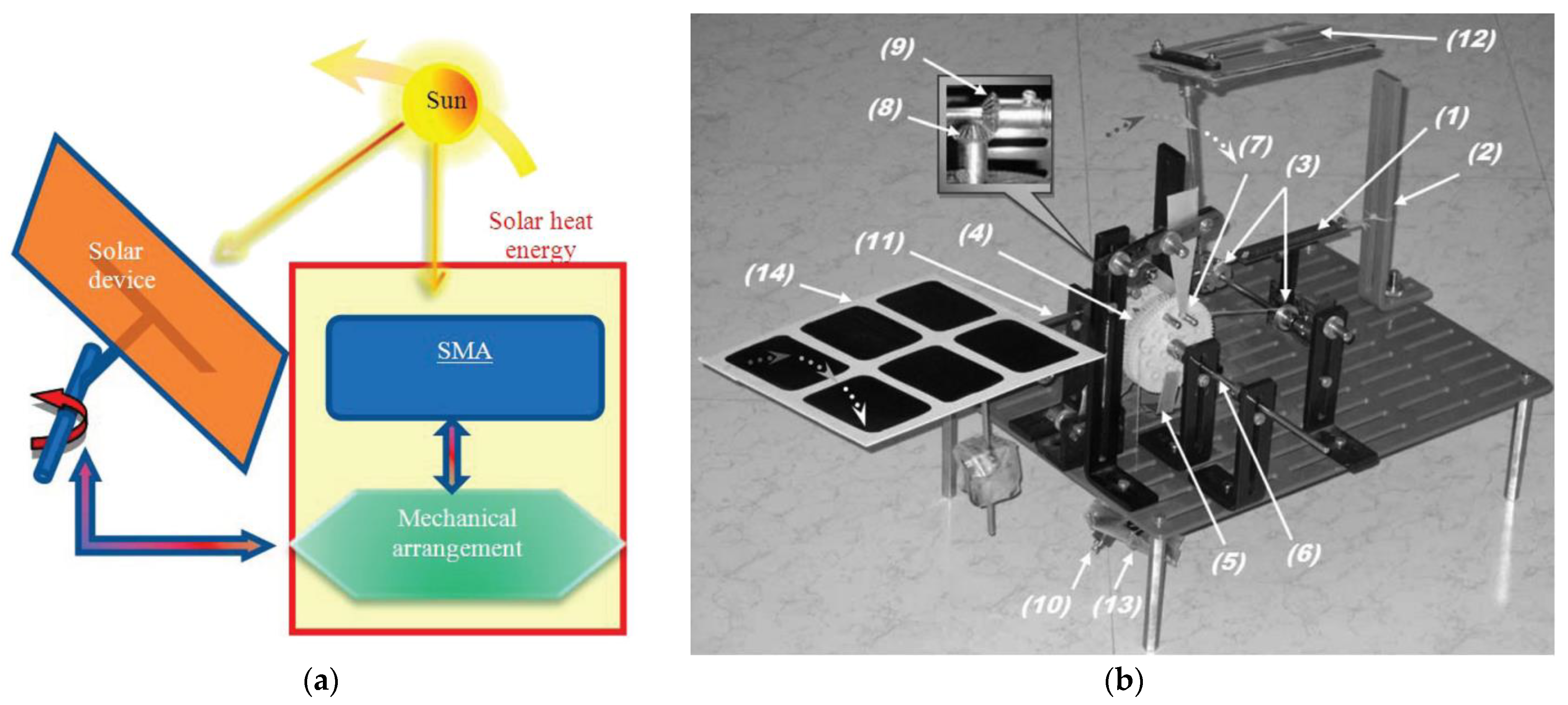
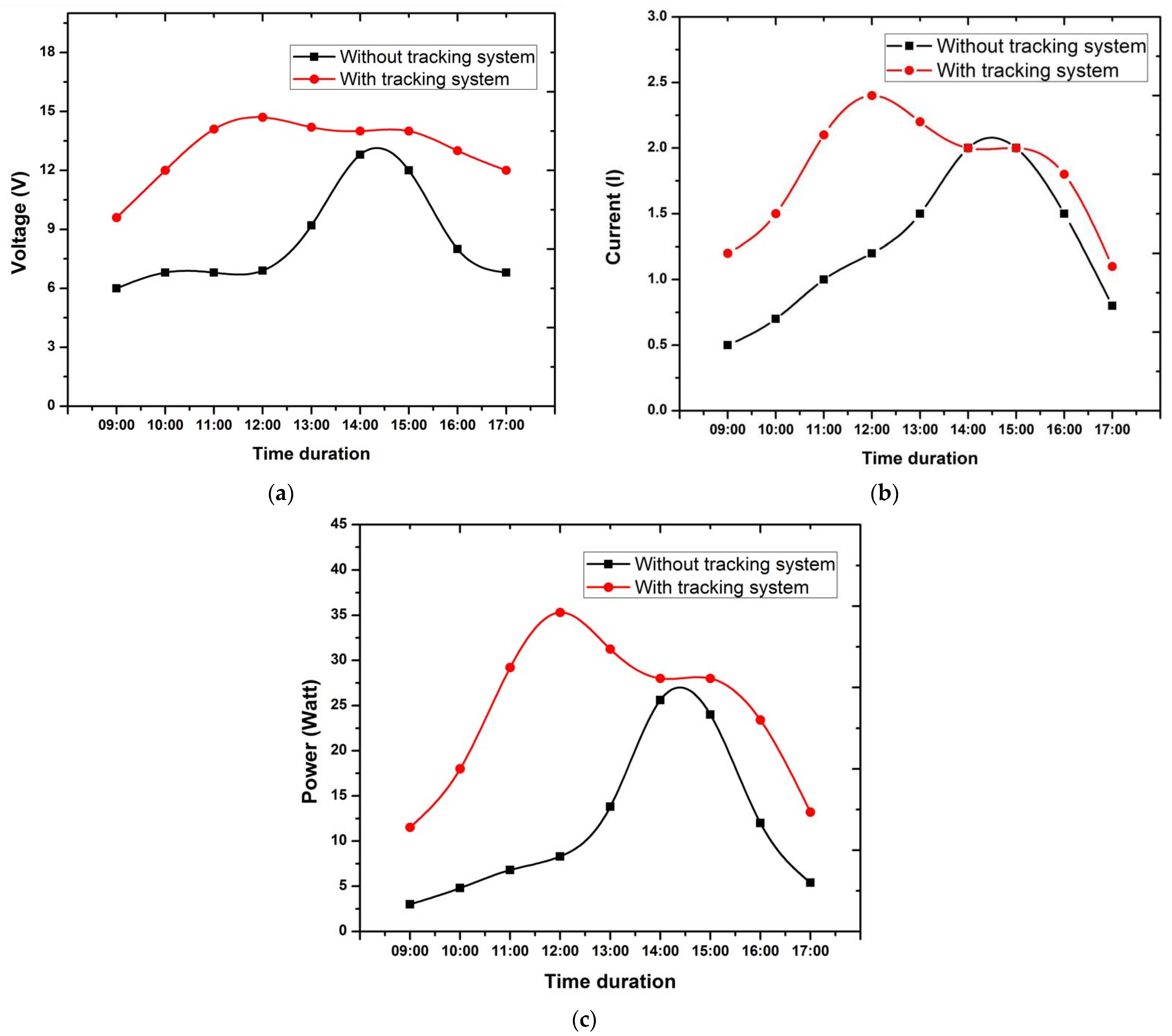

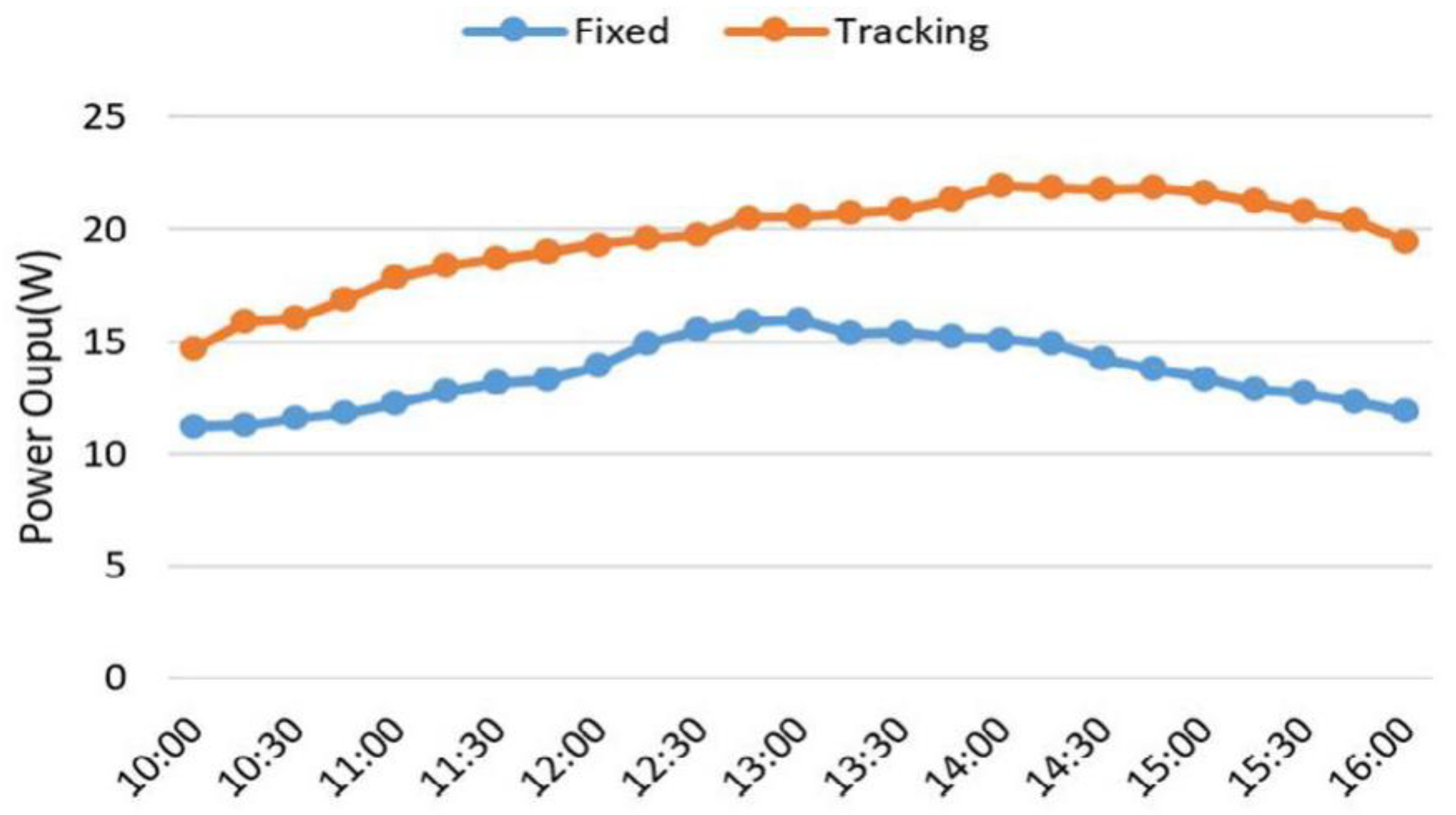
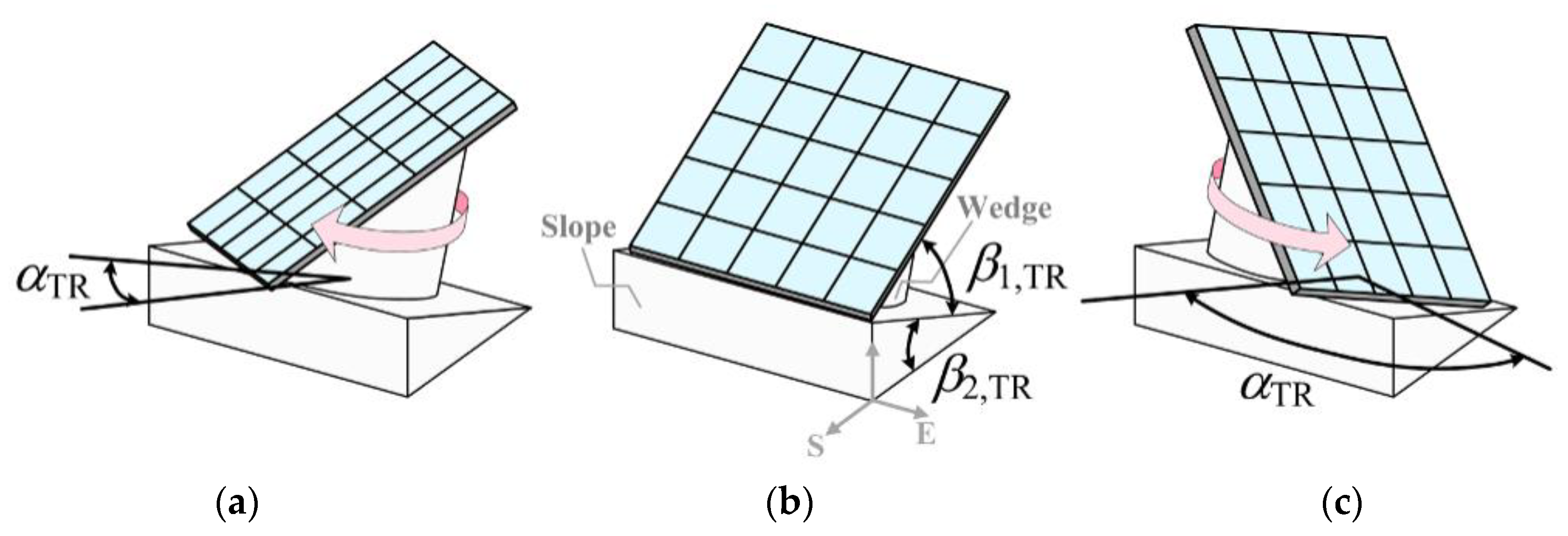

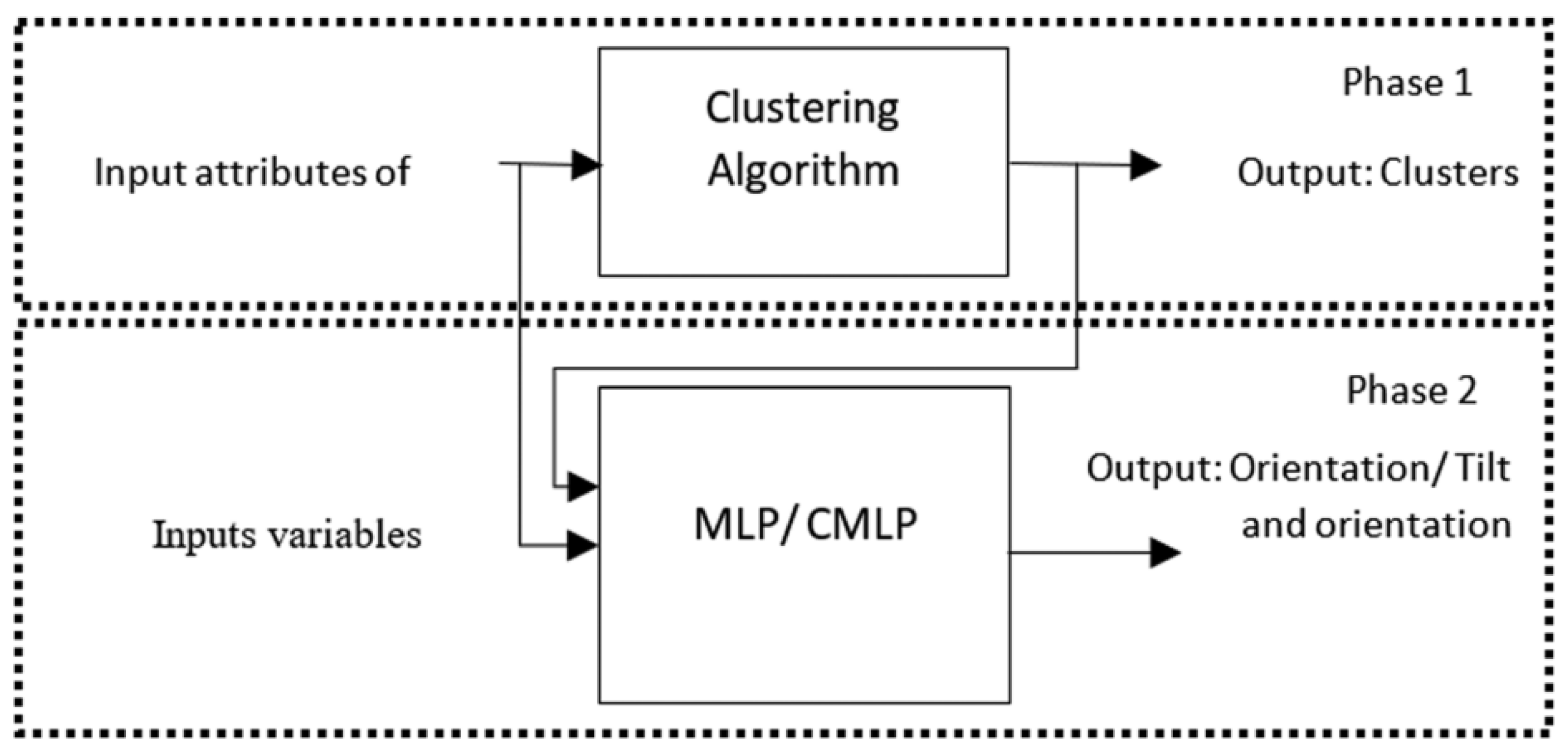
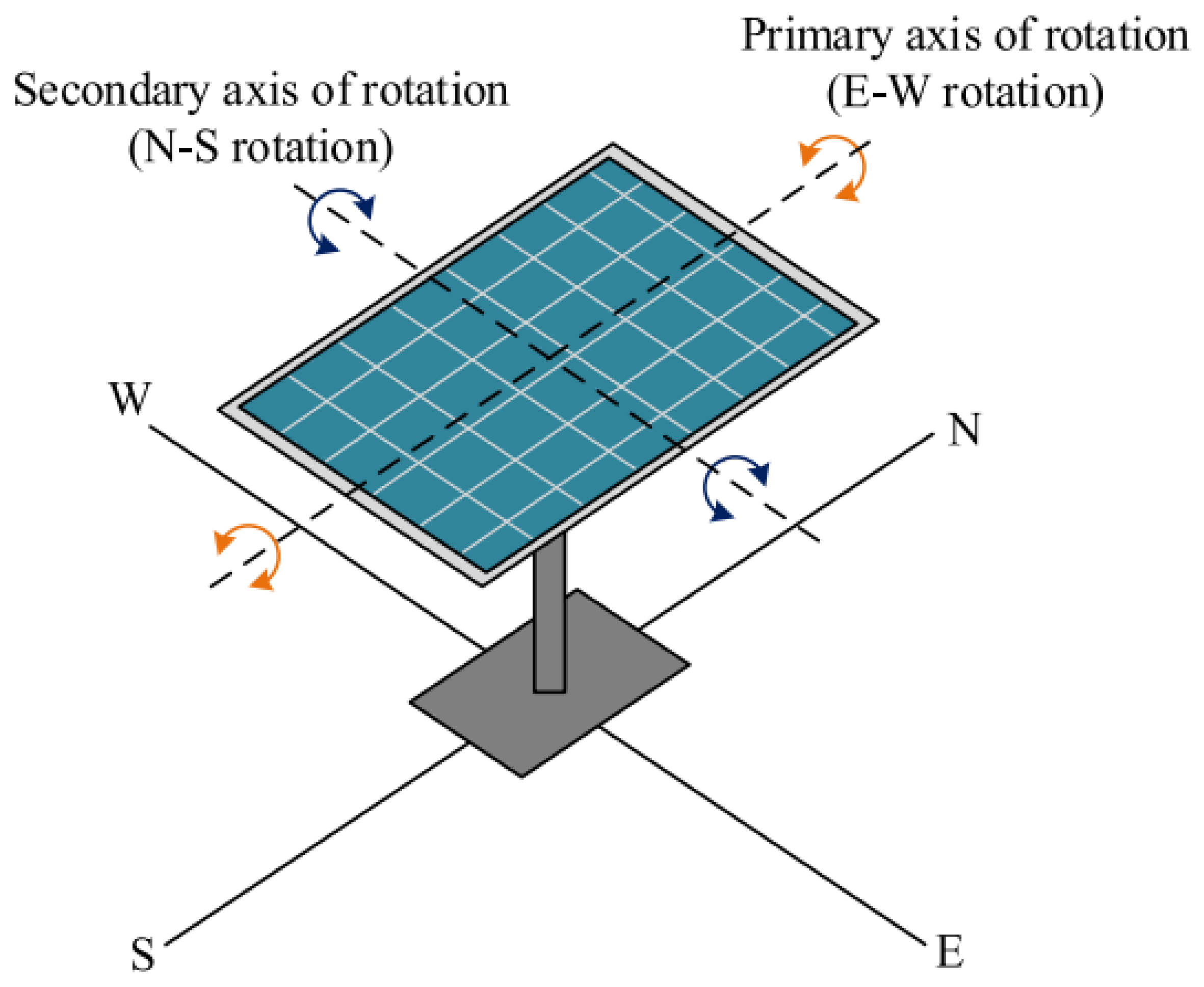
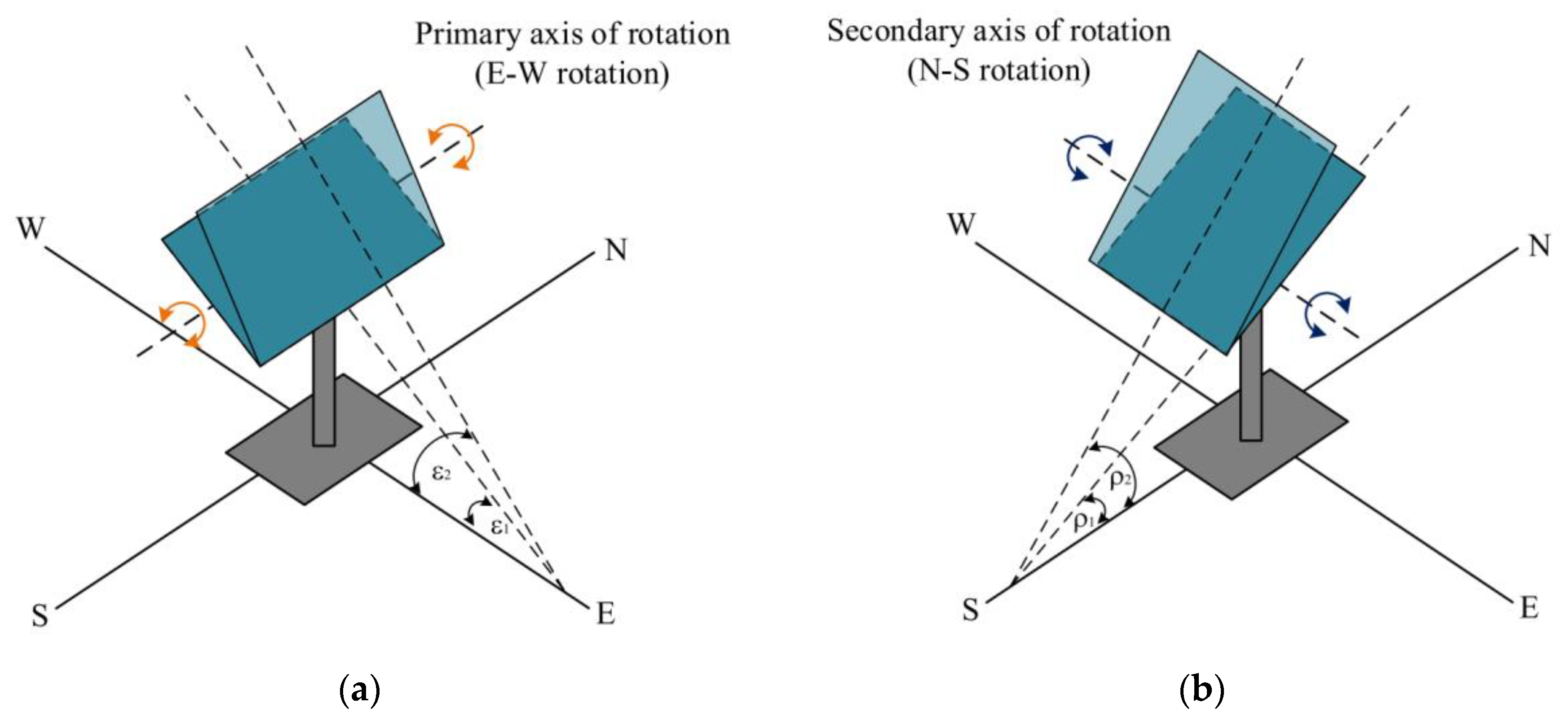

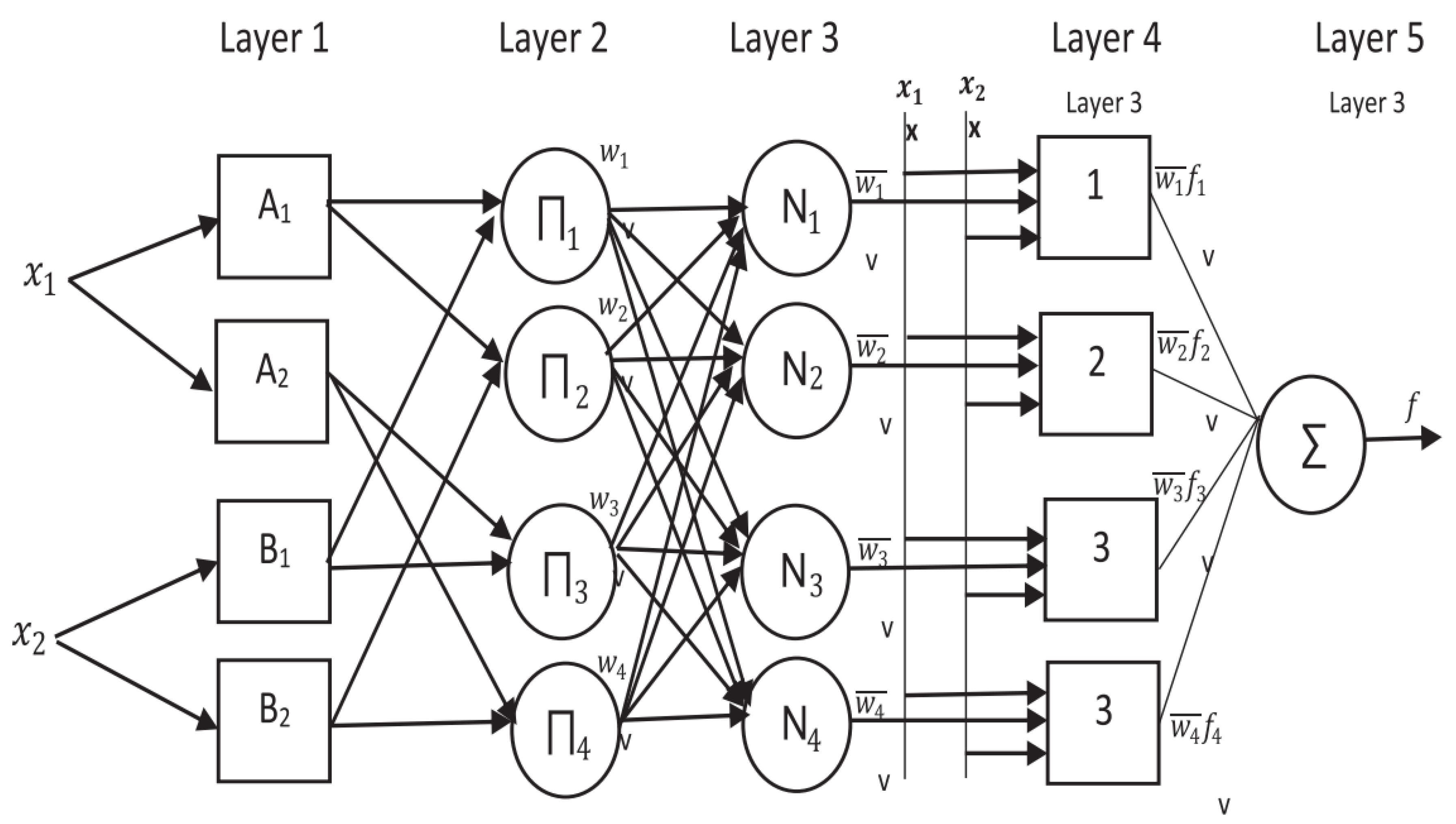
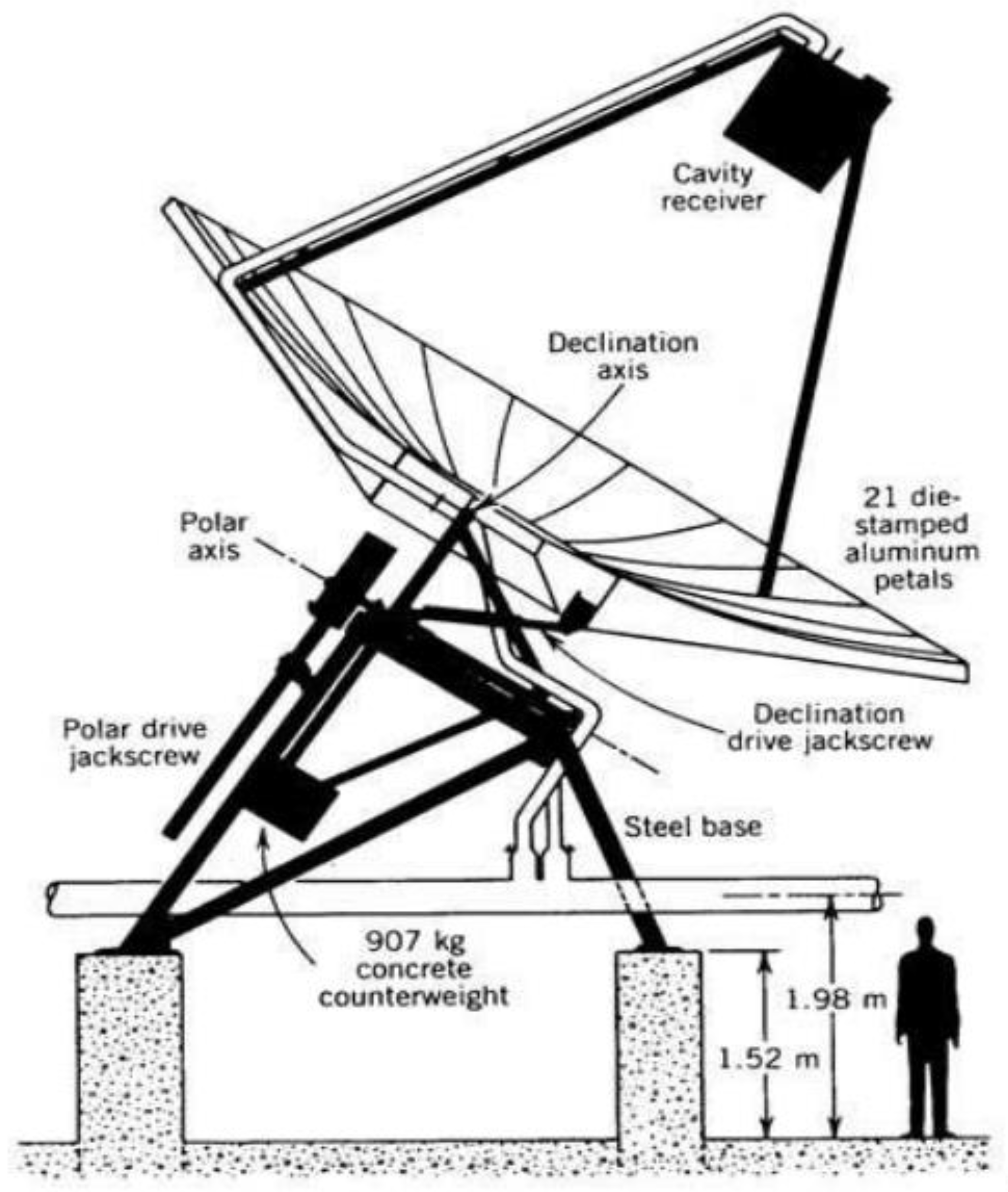
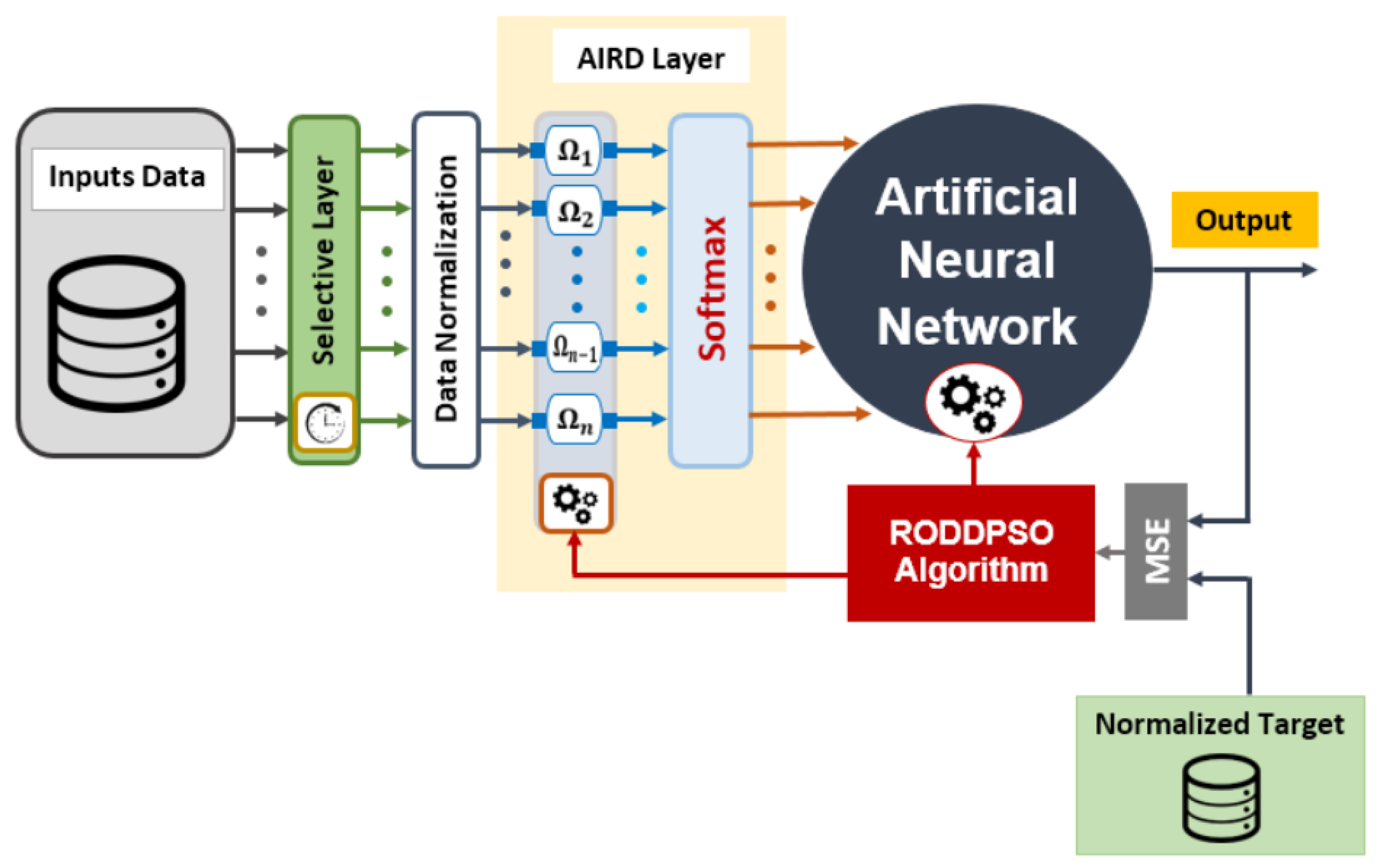
| Number | Parameters | Formulas | Comments | Terminologies | References |
|---|---|---|---|---|---|
| 1 | Coefficient of Correction | Coefficient of correction for solar constant | n takes values from 1 to 365, representing the days. | [28] | |
| 2 | Declination Angle | The angle between the plane of the Earth’s equator and the line connecting the Sun and the Earth’s center | n takes values from 1 to 365, representing the days. | [62] | |
| 3 | Elevation Angle | The angle between the Sun’s rays and the horizon | represents the hour angle, calculated as minutes divided by 4. In this formula, negative values are used for minutes before noon and positive values for minutes after noon. represents the latitude of the region | [63,64] | |
| 4 | Azimuth Angle | The angle measured clockwise from the north along the horizon | represents the solar declination angle | [65] | |
| 5 | Incident Angle | The angle between the surface normal and the incoming sunlight | represents the tilt angle | [66] | |
| 6 | Radiation Intensity | is the Solar constant | [67] | ||
| 7 | Maximum Radiation Intensity | [68] | |||
| 8 | Radiation Intensity Vertical to the Photovoltaic Panel | represents the ratio of radiation intensity perpendicular to the photovoltaic panel to the radiation intensity reaching the horizontal plane, | [68] | ||
| 9 | Diffuse Radiation Intensity on Tilted Surface | represents the diffuse radiation intensity, | [69] | ||
| 10 | Diffuse Radiation Factor | represents the coefficient of ratio between the radiation intensity reaching a horizontal surface and the maximum radiation intensity, | [70] | ||
| 11 | The Radiation Intensity Reflected Back from the Photovoltaic Panel | represents the surface reflectance of the photovoltaic panel | [71] | ||
| 12 | Total Radiation Intensity | [72,73] |
| System Description | Conclusion | References |
|---|---|---|
| The design of a sensorless tracking system composed of three modes. | Increased output power compared to fixed systems. | Katrandzhiev et al. (2018) [93] |
| The distinctive feature of this system is its model based on single-axis configuration with inner angle deviation control. | This model achieves 96.5% energy gain compared to dual-axis tracking systems. | de Sá Campos et al. (2021) [94] |
| The system utilizes the second-order lever principle, avoiding the need for external motors for axial movement of the solar panels. | Compared to traditional single-axis tracking systems, it achieves higher efficiency. | Kumba et al. (2022) [95] |
| The distinctive feature of this system is that it requires no electricity, electronic components, or special materials. The tracking mechanism utilizes wind energy at night, using stored potential energy as its driving force. | The arithmetic mean of the absolute tracking accuracy throughout the year is less than 0.5°, with a standard deviation less than 0.75°. | Elsayed et al. (2021) [96] |
| The system features the use of an Android application-based monitoring interface. | The average power output is increased by over 25% compared to the fixed PV system. | Rinaldi et al. (2020) [97] |
| The system features real-time monitoring of the single-axis solar tracker using the Internet of Things. | All data can be sent normally and monitored online directly. | Pulungan et al. (2020) [98] |
| The system features the subdivision of angular range into discrete angles, calculated for each angle based on the assumed clear-sky model irradiance. | An energy gain between 22.9% and 31.9% was achieved compared to fixed tilted panels. | Alvarado-M et al. (2020) [99] |
| Low cost. | Effective tracking implementation. | Jadli et al. (2018) [100] |
| The system is based on Arduino and LDRs. | The efficiency is improved by 55.2% compared to fixed solar panels. | Maarof and Hiwa Abdlla. (2022) [101] |
| The system utilizes an intelligent single-axis solar tracking system to power the water pump. | Provides a more economical solution. | Abhilash et al. (2021) [102] |
| The system utilizes a single-axis solar tracking system to assist a hybrid wind turbine in harvesting energy from moving vehicles. | The feasibility of harvesting energy from moving vehicles on highways was demonstrated. | Kumar et al. (2020) [103] |
| The system features the idea of implementing solar trackers in solar vehicles. | It can enhance the energy collection of the system. | Almajali et al. (2023) [104] |
| Wind tunnel anti-interference testing of single-axis ST array. | Elucidating the disturbance characteristics and mechanisms of torsional vibrations in single-axis ST array under wind conditions. | Zhang et al. (2023) [105] |
| The system relies on the polar coordinates of the Sun at different positions and time intervals, implementing a planned tracking of the Sun’s position in the sky. | During the peak periods of solar maximization, a constant power gain curve was obtained. | Kher et al. (2022) [106] |
| The system employs a novel strategy to find the optimal energy collection. | Reduced the energy supply for motors. | Saputra et al. (2021) [107] |
| System Description | Conclusion | References |
|---|---|---|
| The system has low maintenance costs and can be installed in remote areas. | Compared to fixed systems, the tracking system achieves an average gain of 23.4%. | Hoffmann et al. (2018) [121] |
| Tracking the Sun’s movement trajectory using a microcontroller and an LDR. | The efficiency of the dual-axis tracker is 25% higher than that of the single-axis tracker. | Sawant et al. (2018) [122] |
| The system is characterized by low cost and simple structure. | The efficiency is higher than that of fixed systems. | Mustafa et al. (2018) [123] |
| The characteristic of this study is the design of a dual-axis STS using Wheatstone bridge circuit-based LDR sensors. | The output power is higher than that of the fixed system. | Saeedi et al. (2021) [124] |
| The system is designed for rural areas, featuring low cost and high reliability. | It generates 31.4% more energy than single-axis tracking systems and 67.9% more energy than fixed solar panels. | Amadi et al. (2019) [125] |
| This system utilizes a dual-axis tracking system to enhance the performance of PV-thermal modules based on nanofluids. | It achieves higher efficiency compared to single-axis tracking and fixed systems. | Taheri et al. (2021) [126] |
| The study combines computer vision and PV sensors to achieve dual-axis ST. Its unique feature lies in the coordination between image processing and PV sensors. | It can avoid interference from cloud cover. | Ahmed et al. (2021) [127] |
| The system is designed for educational purposes, featuring low cost and the ability to efficiently collect and process photovoltaic energy. | The energy efficiency has increased by approximately 32%. | Vargas et al. (2022) [128] |
| The system utilizes Proteus ISIS 7.6 software package to enhance the performance of the dual-axis STS. | The efficiency is increased by 40%. | Pawar et al. (2021) [129] |
| The system features real-time monitoring of PV panel characteristics (voltage, current, and power) using a current sensor (ACS712 current sensor) and a voltage divider circuit. | The system offers a 20% increase in efficiency compared to fixed photovoltaic systems. | Hamad et al. (2020) [130] |
| The system features reduced panel temperatures. | The effectiveness of the system has been validated. | Gaeid et al. (2020) [131] |
| The system takes into account the elimination of shadows between collectors and optimizes the collection of global solar irradiance during tracking and backtracking. | The system improves energy yield by at least 2% compared to existing tracking strategies. | Fernández-Ahumada et al. (2020) [132] |
| The system utilizes a single motor to design an asymmetrically structured dual-axis STS. | Compared to fixed solar energy systems, the system generates 25% to 38% more electricity daily. | Karabiber et al. (2023) [133] |
| The system integrates a dual-axis solar tracker, Internet of Things street lighting, and an efficient traffic management system utilizing deep learning. | It is an efficient and cost-effective system. | Saifuzzaman et al. (2020) [134] |
| A dual-axis elliptical solar tracking concentrated PV system was designed and manufactured. | The tracking error is 0.5°. | Badr et al. (2021) [135] |
| A self-adaptive control-based dual-axis STS has been proposed, capable of operating under cloudy weather conditions | The results show an efficiency improvement of 41% compared to dual-axis scheduled trackers. | Saymbetov et al. (2021) [136] |
| The system designed an automatic cleaning device for solar panels. | The integrated model outperforms single-axis tracking and fixed systems. | Gavaskar et al. (2023) [137] |
| The system utilizes a worm gear mechanical structure. | The system is capable of actively tracking the Sun. | Prakash et al. (2022) [138] |
| The system integrates the Internet of Things into the proposed system, enabling real-time monitoring of the solar panel output performance through the Blynk application and Thing Speak website. | It can capture an additional 27.4% of solar power compared to the fixed tilt axis. | Nazri et al. (2022) [139] |
| A solar tracker based on a fuzzy logic controller has been designed. | The efficiency is improved compared to the fixed system. | Rosyadah et al. (2022) [140] |
Disclaimer/Publisher’s Note: The statements, opinions and data contained in all publications are solely those of the individual author(s) and contributor(s) and not of MDPI and/or the editor(s). MDPI and/or the editor(s) disclaim responsibility for any injury to people or property resulting from any ideas, methods, instructions or products referred to in the content. |
© 2023 by the authors. Licensee MDPI, Basel, Switzerland. This article is an open access article distributed under the terms and conditions of the Creative Commons Attribution (CC BY) license (https://creativecommons.org/licenses/by/4.0/).
Share and Cite
Yang, Z.; Xiao, Z. A Review of the Sustainable Development of Solar Photovoltaic Tracking System Technology. Energies 2023, 16, 7768. https://doi.org/10.3390/en16237768
Yang Z, Xiao Z. A Review of the Sustainable Development of Solar Photovoltaic Tracking System Technology. Energies. 2023; 16(23):7768. https://doi.org/10.3390/en16237768
Chicago/Turabian StyleYang, Zihan, and Zhiquan Xiao. 2023. "A Review of the Sustainable Development of Solar Photovoltaic Tracking System Technology" Energies 16, no. 23: 7768. https://doi.org/10.3390/en16237768
APA StyleYang, Z., & Xiao, Z. (2023). A Review of the Sustainable Development of Solar Photovoltaic Tracking System Technology. Energies, 16(23), 7768. https://doi.org/10.3390/en16237768





